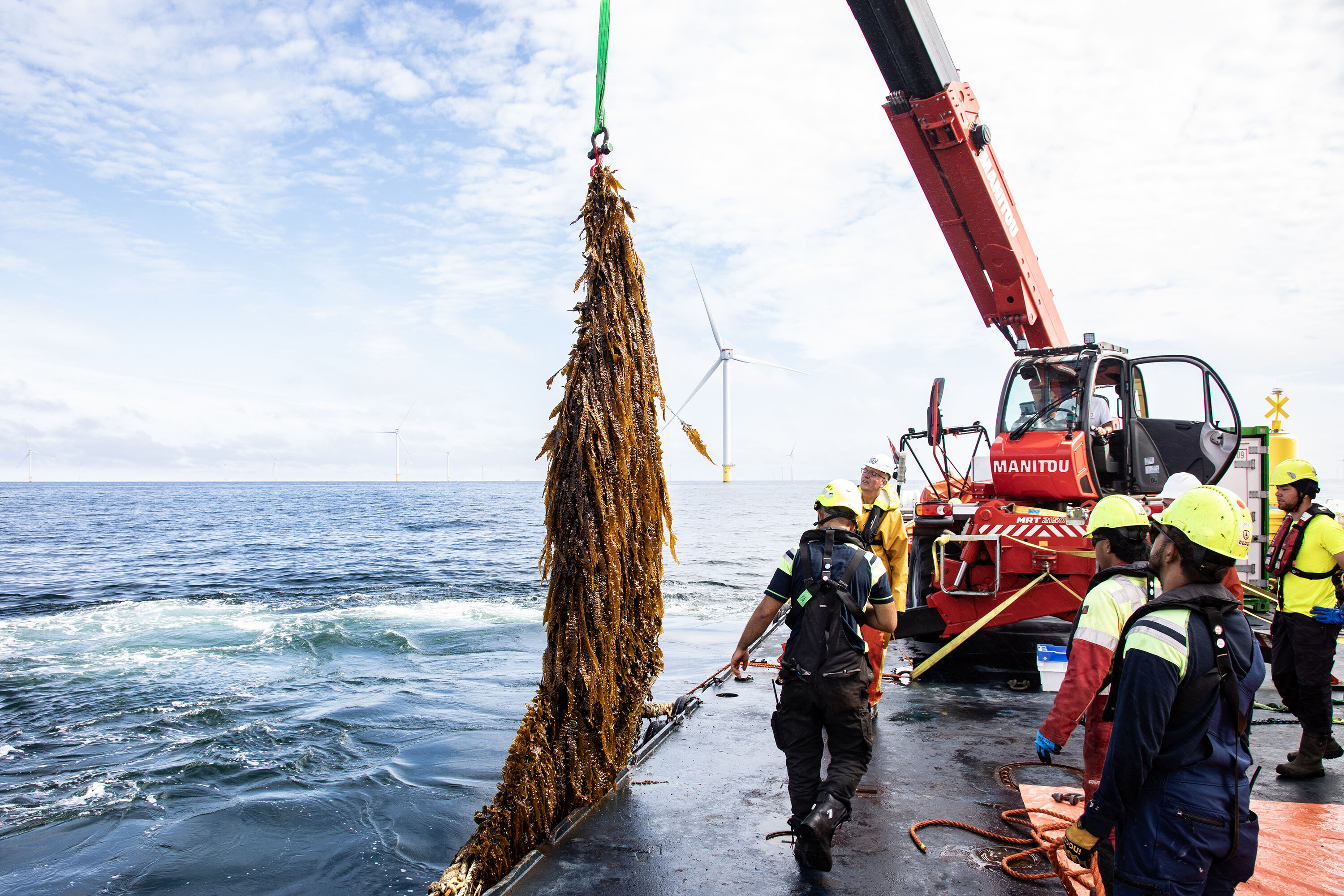First-ever harvest at pioneering North Sea seaweed farm, funded by Amazon’s Right Now Climate Fund
Share
Harvest at world’s first commercial-scale seaweed farm located between wind turbines provides researchers with valuable insights into seaweed cultivation.
Issued 14th July 2025 - North Sea Farmers have made the first-ever harvest at North Sea Farm 1, a commercial-scale seaweed farm located off the coast of the Netherlands in the North Sea. The farm, uniquely located within a field of wind turbines, was created by North Sea Farmers, a non-profit supported by Amazon’s Right Now Climate Fund—a $100 million initiative dedicated to climate and biodiversity projects that benefit both people and the planet.
The harvest provides valuable insights to researchers investigating how seaweed farms remove carbon from the atmosphere, contribute to climate resilience, and how to scale seaweed cultivation globally. In the longer term, seaweed farms may also support biodiversity and reduce pressure on agricultural land.
The innovative project received €2 million in funding from Amazon's Right Now Climate Fund.
By locating the farm between offshore wind turbines, North Sea Farmers secured physical space protected from maritime traffic in the North Sea.

“Through ongoing scientific research, we aim to demonstrate whether farms like this can have a positive long-term impact on both biodiversity and climate change mitigation,” said Eef Brouwers, Managing Director of North Sea Farmers. “At the same time, we're proving that seaweed production within an existing offshore infrastructure is possible at a commercial scale.”
The harvesting process at North Sea Farm 1 involves a specially equipped vessel navigating between turbines to collect mature seaweed from four large nets, each measuring 50 metres by 3 metres, anchored to the seabed. Crews use tailored equipment to gather the crop, which spans five hectares of the North Sea.
The harvested seaweed can be processed into a wide range of items, including textiles, foods, and wellness products, demonstrating its commercial relevance for European markets. Because seaweed requires no land, fresh water, or fertilisers to grow, it offers a sustainable alternative to land-based crops.
A team of researchers working with North Sea Farmers—Plymouth Marine Laboratory, Deltares, and Silvestrum Climate Associates—has been monitoring the farm using satellite data and site visits over the past year. Following the harvest, the research partners will deliver a full analysis of seaweed growth, carbon absorption rates, and environmental impact, including potential effects on local wildlife.
Professor Ana M. Queirós, Plymouth Marine Laboratory’s Climate Change Lead and lead scientist on the project, said: “We’re very excited to understand the effects of the seaweed farm on the immediate and surrounding marine environment. Our analysis will follow the carbon from the seawater into the seaweed and surrounding ecosystem, and assess any effects on biodiversity. We will be collecting seabed and water samples, conducting in-situ monitoring of marine life, and using advanced eDNA techniques to build a detailed understanding of the developing habitat and its species. Projects like this must be grounded in strong science, particularly given the urgency of the climate and biodiversity crisis and the need for scalable, sustainable solutions.”
The harvest at this pioneering farm—located within the Hollandse Kust Zuid (HKZ) wind farm, approximately 18 kilometres off the coast of Scheveningen—has been three years in the making. The project was conceived in 2022 and the first seaweed was planted in October 2024.
Irish-led delivery
Irish company Simply Blue Group, a blue economy project developer headquartered in Ireland, led the seaweed cultivation through its dedicated seaweed entity, Óir na Farraige.
Gareth Murphy, Project Manager at Óir na Farraige, said: “When I joined the company, I was asked a straightforward question: can we utilise the space between offshore wind turbines for seaweed cultivation? We now know the answer is yes. We’ve proven that seaweed can be successfully grown 14 miles offshore, within a functioning wind farm. It’s been a challenge, but it’s hugely rewarding to see it delivered.”
“This was once considered unrealistic—from the engineering complexity to securing consent and operational agreements. Yet, we’ve not only achieved a harvest but also secured offshore consent within an active wind farm and agreed a formal cooperation framework with the wind farm owner, Vattenfall. That agreement provides a model for future co-location—whether for aquaculture, ecosystem restoration, or floating solar.”
“In the Netherlands, this project went from concept to harvest in under three years. Over that same period, we're still awaiting approval for a nearshore seaweed licence in Ireland. It highlights the potential of the blue economy—and the importance of enabling conditions to unlock it.”
Consortium led by North Sea Farmers
North Sea Farmers (NSF) is leading this project with the goal of gathering essential evidence for the wider sector. The consortium includes researchers from Plymouth Marine Laboratory (PML), Deltares, and Silvestrum Climate Associates, seaweed extract manufacturer Algaia, project developer Simply Blue Group, and maritime contractors Van Oord and Doggerland Offshore.
ENDS
For more information please contact:
Sara Dymond.